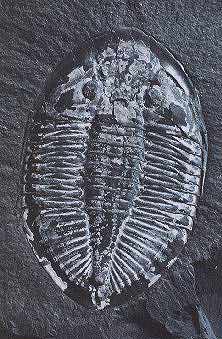 Pseudogygites latimarginatus, Collingwood Member, Lindsay Formation,
Bowmanville, Ontario
Pseudogygites latimarginatus, Collingwood Member, Lindsay Formation,
Bowmanville, Ontario
photo courtesy K. Brett
July 2001:
Pseudogygites:
 Pseudogygites latimarginatus, Collingwood Member, Lindsay Formation,
Bowmanville, Ontario
Pseudogygites latimarginatus, Collingwood Member, Lindsay Formation,
Bowmanville, Ontario
photo courtesy K. Brett
The endemic North American asaphid trilobite, Pseudogygites latimarginatus, is one of the most common trilobites from southern Ontario. It occurs in starta of possibly Edenian to Maysvillian and Richmondian ages (Ashgillian) of the Upper Ordovician. Formerly this species was called Pseudogygites canadensis, however Ludvigsen (1979) renamed it P. latimarginatus based on the fact that Asaphus? latimarginata Hall (1847) pre-dated the description of Asaphus canadensis Chapman (1856).
P. latimarginatus occurs in the Collingwood
Member of the Lindsay Formation in southern Ontario. Formerly, this unit
was called the Lower Member of the Whitby Formation although this unit
was renamed recently to the uppermost member (Collingwood) of the Lindsay
(or Cobourg) Formation based mainly on lithological grounds. P. latimarginatus
also occurs rarely in the Whitby Formation itself, as well as in equivalent
strata (Billings Formation) in the Ottawa - St. Lawrence Lowlands. The
most common occurences are in the Collingwood Member at Bowmanville and
Craigleith Ontario.
The exoskeletons occuring in these units are
flat, and preserved in a black calcareous to bituminous shale. Usually
they occur as abundant partials although complete specimens are fairly
common, with some death layers having been discovered (Craigleith and Bowmanville).
Many multiple death slabs have been found, some exceeding 20 complete specimens
on the same slab. These layers are no longer accessible as at Craigleith
they are in a park and at Bowmanville the layer was mined out by commercial
collectors and quarry operations.
This species also occurs in the upper layers of the Lindsay (Cobourg) Formation (Hillier Member), in shale partings between the limestone layers and sometimes in the limestone itself. Again these are usually disarticulated remains, although very rarely a complete 3-dimensional 'Pseudo' is found. Furthermore, P. latimarginatus also occurs on Manitoulin Island, in northern Michigan, in the Oshawa-Whitby area of Ontario, in New York (Utica Shale Fm., Watertown area), and possibly in the Utica Shale of the Quebec City area.
3 other species are described (Ludvigsen, 1979). These are:
'Pseudos' (as they are commonly called by collectors) (see Fossil collecting jive compiled by Mark Behrendt) are one of the more affordable complete trilobites for collectors. Both the part (positive) and counterpart (negative) impressions are attractive. Juvenile holaspids and even meraspids have been found in the black shale layers as well. Among other things, the genal spines decrease in length through ontogeny.
References:
Brett K. and Rudkin, D. (1997) Ordovician stratigraphy and trilobite faunas of south central Ontario. Field trip 3, Guidebook, 2nd International Trilobite Conference, Brock University, St. Catharines, Ontario.
Kobayashi (1934) The Cambr-Ordovician formations and faunas of South Chosen. Palaeontology. Part 1. Middle Ordovician Faunas. Journal of the Faculty of Science, Imperial University of Tokyo, sect. 2, 3:329-519.
Ludvigsen (1979) The Ordovician Trilobite Pseudogygites Kobayashi in Eastern and Arctic North America. Life Sciences Contributions Number 120, Royal Ontario Museum, pp. 1-41.
further references may be obtained from Ludvigsen, 1979.
slab Pseudogygites latimarginatus, Collingwood Member, Lindsay Formation,
Bowmanville, Ontario. Photo courtesy K. Brett
juvenile holaspid (on above slab)
photo courtesy K. Brett
holaspid negative impression
photo courtesy K. Brett
photo courtesy K. Brett
A very nice slab at: House
of Phacops.
A nice single at the Humboldt
State University Natural History Museum.
At the GSC: "The trilobite Pseudogygites
latimarginatus (GSC Type Fossil No. 1924c) found by Alexander Murray
at Collingwood in 1848. Fossils were used by Murray in 1845 to show that
black oil shales of Collingwood were the same age as similar rocks in the
Windsor area and New York State (GSC 1993-132C)."
A nice Pseudo
at the ROM (photo by Dave Rudkin).